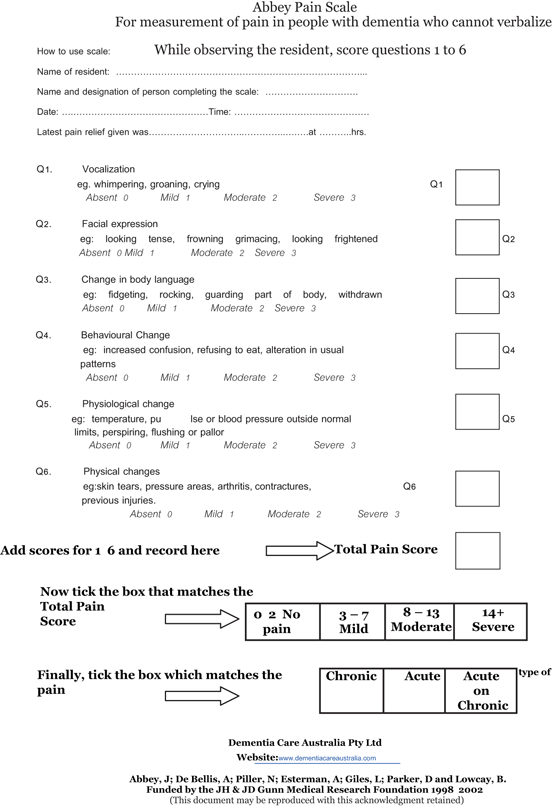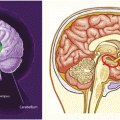Instructions for Usage
Explain to the person that each face is for a person who has no pain (hurt), some pain, or a lot of pain.
Face 0 does not hurt at all. Face 2 hurts just a little bit. Face 4 hurts a little bit more. Face 6 hurts even more. Face 8 hurts a whole lot. Face 10 hurts as much as you can imagine, although you do not have to be crying to have this worst pain.
Ask the person to choose the face that best depicts the pain they are experiencing.
There are two other excellent tools used to assess and quantify pain in those with AD.
One is the Abbey Scale—developed in Australia (Abbey et al. 1998–2002).

The other is the pain assessment in advanced dementia (PAINAD) . This tool evaluates the following five descriptive elements that are impacted by pain.
This pain tool is used to assess pain in older adults who have dementia or significant cognitive impairment that makes them unable to reliably communicate their pain. It can be used by a nurse or by a CNA to screen for pain-related behaviors. The tool should be used at admission, at scheduled quarterly assessments , during every shift if there is indication that pain is not controlled, each time a change in pain status is reported, and following a pain intervention to evaluate treatment effectiveness (within 1–2 h). The PAINAD is used by observing the older adult for 3–5 min during activity/with movement (such as bathing, turning, transferring) . For each item included in the PAINAD , select the score (0, 1, 2) that reflects the current state of the behavior. Add the score for each item to achieve a total score. Total scores range from 0 to 10 (based on a scale of 0 to 2 for each of five items), with a higher score suggesting more severe pain (0 = “no pain” to 10 = “severe pain”). The score is reported by the nursing assistant to the nurse who does a follow-up assessment. The score is documented and shared with all other health care providers. Behavior observation scores should be considered alongside knowledge of existing painful conditions and reports from someone who knows the older adult (like a family member or nursing assistant) and their pain behaviors. It is very important to remember that some older adults may not demonstrate obvious pain behaviors or cues.
Pain Assessment in Advanced Dementia Scale (PAINAD)
Instructions: Observe the patient for 5 min before scoring his or her behaviors. Score the behaviors according to the following chart. Definitions of each item are provided on the following page. The patient can be observed under different conditions (e.g., at rest, during a pleasant activity, during caregiving, after the administration of pain medication) (Warden et al. 2003).
Behavior | 0 | 1 | 2 | Score |
|---|---|---|---|---|
Breathing Independent of vocalization | Normal | Occasional labored breathing, short period of hyperventilation | Noisy labored breathing, long period of hyperventilation Cheyne–Stokes respirations | – |
Negative vocalization | None | Occasional moan or groan Low-level speech with a negative or disapproving quality | Repeated troubled calling out Loud moaning or groaning Crying | – |
Facial expression | Smiling or inexpressive | Sad Frightened Frown | Facial grimacing | – |
Body language | Relaxed | Tense Distressed pacing Fidgeting | Rigid Fists clenched Knees pulled up Pulling or pushing away Striking out | – – – |
Consolability | No need to console | Distracted or reassured by voice or touch | Unable to console, distract, or reassure | – |
Total score | – |
Scoring: The total score ranges from 0 to 10 points. A possible interpretation of the scores is: 1–3 = mild pain; 4–6 = moderate pain; 7–10 = severe pain. These ranges are based on a standard 0–10 scale of pain, but have not been substantiated in the literature for this tool.
Source: Warden et al. (2003).
PAINAD Item Definitions
Source: Warden et al. (2003).
Breathing
1.
Normal breathing is characterized by effortless, quiet, rhythmic (smooth) respirations.
2.
Occasional labored breathing is characterized by episodic bursts of harsh, difficult, or wearing respirations.
3.
Short period of hyperventilation is characterized by intervals of rapid, deep breaths lasting a short period of time.
4.
Noisy, labored breathing is characterized by negative-sounding respirations on inspiration or expiration. They may be loud, gurgling, wheezing. They appear strenuous or wearing.
5.
Long period of hyperventilation is characterized by an excessive rate and depth of respirations lasting a considerable time.
6.
Cheyne–Stokes respirations are characterized by rhythmic waxing and waning of breathing from very deep to shallow respirations with periods of apnea (cessation of breathing).
Negative Vocalization
1.
None is characterized by speech or vocalization that has a neutral or pleasant quality.
2.
Occasional moan or groan is characterized by mournful or murmuring sounds, wails, or laments. Groaning is characterized by louder than usual inarticulate involuntary sounds, often abruptly beginning and ending.
3.
Low-level speech with a negative or disapproving quality is characterized by muttering, mumbling, whining, grumbling, or swearing in a low volume with a complaining, sarcastic, or caustic tone.
4.
Repeated troubled calling out is characterized by phrases or words being used over and over in a tone that suggests anxiety, uneasiness, or distress.
5.
Loud moaning or groaning is characterized by mournful or murmuring sounds, wails, or laments in much louder than usual volume. Loud groaning is characterized by louder than usual inarticulate involuntary sounds, often abruptly beginning and ending.
6.




Crying is characterized by an utterance of emotion accompanied by tears. There may be sobbing or quiet weeping.
Stay updated, free articles. Join our Telegram channel

Full access? Get Clinical Tree




